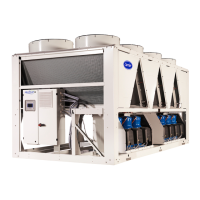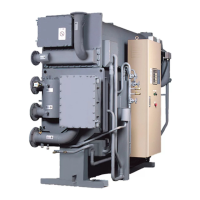Point 10 represents the strong solution leaving the low-stage
generator and entering the low-temperature heat exchanger.
It is at a weaker concentration than the solution from the
high-stage generator, and can be plotted approximately by
measuring the temperatures of the leaving strong solution
and vapor condensate (saturation temperature). This condi-
tion cannot be measured accurately.
Point 11 represents the mixture of strong solution from the
high-temperature heat exchanger and strong solution from
the low-stage generator as they both enter the low-temperature
heat exchanger. The temperature can be measured on those
models which have separate solution heat exchangers.
Point 12 represents the combined strong solution before it
leaves the low-temperature heat exchanger after giving up
heat to the weak solution. This condition is internal and can-
not be measured.
Point 13 represents the strong solution leaving the low-
temperature heat exchanger and entering the absorber spray
nozzles, after being mixed with some weak solution in the
heat exchanger. The temperature can be measured, but the
concentration cannot be sampled. After leaving the spray
nozzles, the solution is somewhat cooled and concentrated
as it flashes to the lower pressure of the absorber, at
Point 1.
Table2—Typical Full Load Cycle Equilibrium Data
POINT
SOLUTION TEMPERATURE VAPOR PRESSURE
SOLUTION PERCENTAGE
(Lithium Bromide)
SATURATED TEMPERATURE
F C in. Hg mm Hg F C
1 110 43 0.24 6 62.2 40 4
2 95 35 0.24 6 58.0 40 4
3 149 65 1.10 29 58.0 83 28
4 160 71 1.50 39 58.0 93 34
5 167 75 2.00 50 58.0 100 38
6 277 136 19.00 490 58.0 191 88
7 289 143 24.00 600 58.0 200 93
8 318 159 24.00 600 63.6 200 93
9 167 75 1 10 28 63.6 82 28
10 180 82 2.00 49 61.3 100 38
11 176 80 1.60 40 62.2 93 34
12 117 47 0.31 8 62.2 46 8
13 111 44 0.28 7 61.5 43 6
LCD — Level Control Device
TC — Temperature Control (Capacity Control)
Fig. 7 — Equilibrium Diagram and Chiller Solution Cycle
8

